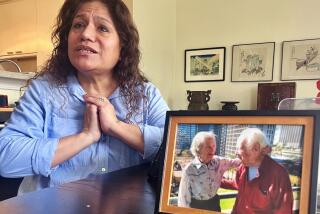Our Dreyfuss Affair
- Share via
In Oct. 5, 1972, Henry Dreyfuss walked into the garage of his home in South Pasadena. His wife walked with him. She was dying of cancer. They had been married for 42 years.
The two of them got into their car, turned on the ignition, and waited. Within a few minutes they both died. They had lived their life together and ended it together.
I happened to attend the funeral, as a matter of courtesy. Dreyfuss’ son was an acquaintance of mine. Otherwise, I didn’t know Henry Dreyfuss, didn’t know of him or his life.
By and large, the rest of L.A. could have said the same. Didn’t know him, didn’t know of him, and didn’t much care. Here in Los Angeles we have a special way of making invisible anyone and everyone whose face does not get smacked up there on the Silver Screen. Even those who happened to have created a big chunk of the 20th century.
Now, 25 years later, New York has seen fit to honor Henry Dreyfuss with a large exhibition of his work. That’s fair enough, in a way, because Dreyfuss maintained offices in both cities.
But here in Los Angeles? Nothing. Never. As far as we’re concerned, if he didn’t run a studio, invent the sitcom, or pump the first breast with silicone, he didn’t exist.
Mind you, it’s not as if Dreyfuss was some arcane rocket scientist. Although, truth be told, we ignore those, too. A man named Edwin Powell Hubbell discovered the fundamental nature of the universe here in Los Angeles and was utterly forgotten until NASA named the space telescope after him.
In any case, Henry Dreyfuss was not arcane at all. Just the opposite. You could say he invented the way the 20th century looks. That’s an exaggeration, of course, but not by much.
You know that AT&T; telephone that sat on your desk or next to your bed in, say, 1980? Dreyfuss designed it. You remember the sex-kitten Princess phone? He designed that, too. Ever own a Polaroid camera? Dreyfuss designed most of them.
You know the round Honeywell thermostat on your wall? Yeah, that too.
How about the 20th Century Limited, perhaps the most elegant train in U.S. history? Yeah.
The green-and-yellow John Deere tractor that still looks so cool?
Hoover vacuum cleaners?
The Big Ben alarm clock?
The Singer sewing machine?
The Royal typewriter of the 1940s?
Yeah. All of them.
Soon we will come to the end of the 20th century. Of all the fashions and “looks” that it produced over the decades, I believe the signature look will come from Henry Dreyfuss and his cohorts.
That era began in the midst of the depression and ended in the ‘50s. It produced a streamlined, soaring style that expressed its utter faith in man’s works. Who can look today at the Empire State building--or Bullocks Wilshire for that matter--and not feel a pang at having missed such a time?
Dreyfuss’ role was not to produce the huge monuments of the era but the everyday objects. Because of that, his influence was as great, if not greater, than that of the monument builders themselves. His objects contained the same elements of faith but were touched and used every day. They still are.
“If Dreyfuss designed a refrigerator, he wanted to produce a design that would last for a long time,” says Russell Flinchum, curator of the New York exhibition.
“Using that standard, he was probably the most successful of all the great industrial designers. Many of his designs are still used today.”
Knockoffs of the Trimline phone, for example, are sold by the thousands. I noticed last week that the Pottery Barn now offers a “retro” bedside clock that is nothing more than a copy of Dreyfuss’ Big Ben.
Other stuff is more subtle. Asked to design the passenger facilities for an ocean liner, Dreyfuss proposed the untried idea of putting a swimming pool on the top deck.
*
The builders said the weight would be too great and topple the ship, so Dreyfuss redesigned the deck chairs, making them aluminum rather than wood, and saved enough weight to allow for the pool.
Today, every passenger ship in the world has a pool on the top deck.
As Flinchum notes, Dreyfuss also had his disappointments. He tried and failed to design a successful airplane/auto in the ‘50s. He also believed that prefabricated houses had a great future, which they did not.
One way or the other, much of the look of the 20th century flowed out of the house and office on Columbia Street in South Pasadena. Dreyfuss’ chief partner in business, as well as life, was his wife, Doris Marks. When she was diagnosed with cancer, they apparently decided to end their lives together when her pain became unbearable. And so they did.
The ending was as remarkable as the life. Today, the house still stands on its elegant acres in South Pasadena. But it looks like just another rich man’s house. You would never guess what happened there.
And L.A., as ever, does not want to guess.


